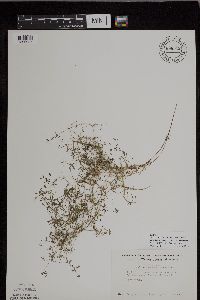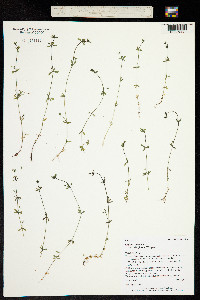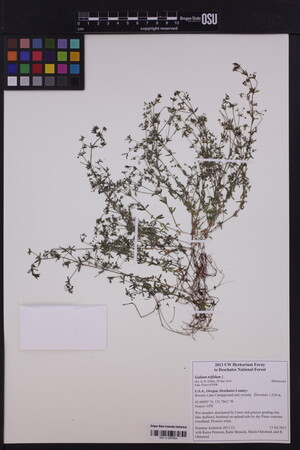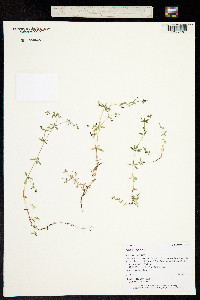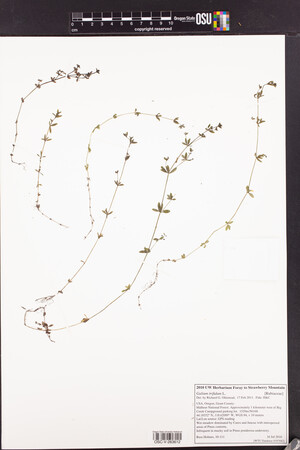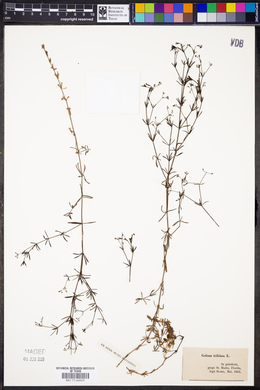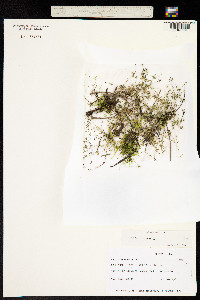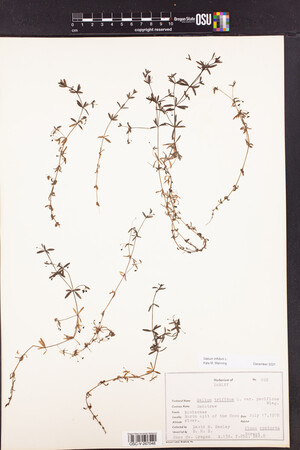Galium trifidum
|
|
|
|
Family: Rubiaceae
Three-Petal Bedstraw, more...threepetal bedstraw, small bedstraw
|
Plant: Variable perennial (rarely annual) herb; 4-6 at nodes, rounded at apices, not bristle-tipped Leaves: 4-6 at nodes, rounded at apices, not bristle-tipped Flowers: perfect; corolla rotate, 3-4-lobed Fruit: FRUITS of 2 hard, spherical, smooth, brown or black mericaps REFERENCES: Dempster, Lauramay T. 1995. Rubiaceae. J. Ariz. - Nev. Sci. 29(l): 29. Perennial herb with a creeping rhizome 10 - 40 cm tall Leaves: mostly in whorls of four, a few in whorls of five or six, 5 mm - 2 cm long, linear to narrowly elliptic with a blunt tip, one-veined, often roughly hairy along the margins and sometimes on the midrib beneath. Flowers: mostly solitary on an elongated (over 6 mm long), arched, rough stalk, axillary or terminal, whitish, 1 - 1.5 mm wide, more or less flat and circular in outline, with three short, blunt lobes. Stamens four, shorter than corolla. Styles two, short. Fruit: dry, indehiscent, 1 - 2 mm long, spherical, paired, separating when ripe, one-seeded. Stems: numerous, weak, often scrambling over other plants, slender, four-angled, often much branched, roughly hairy on the angles or essentially hairless. Similar species: No information at this time. Flowering: mid-June to late September Habitat and ecology: Found in calcareous marshes, bogs, and other moist areas. Occurence in the Chicago region: native Etymology: Galium comes from the Greek word gala, meaning milk, referring to the plants that are used to curdle milk. Trifidum means three-cleft. Author: The Morton Arboretum Heil et al. 2013, Allred and Ivey 2012, Martin and Hutchins 1980 Duration: Perennial Nativity: Native Lifeform: Forb/Herb General: Perennial herb with matted stems that scramble over other vegetation; stems slender and weak, to 50 cm long, 4-angled, retrorsely scabrous on the angles. Leaves: Sessile, in whorls along the stems, with 4 leaves per whorl; blades linear to linear-oblanceolate, 1-2 cm long, hispid or scabrous, especially on the midrib and margins. Flowers: Tiny and white; solitary in leaf axils and in groups of 3 at tips of stems; each flower on a long slender pedicel; sepals abesnt; petals cream colored or greenish, fused into a tube topped with 3 or 4 spreading lobes (rotate). Fruits: Dry, indehiscent fruit (schizocarp) consisting of 2 mericarps, these spherical, smooth, glabrous, and black or dark brown. Ecology: Found on margins of lakes, ponds, and streams, in mountain brush, ponderosa pine and spruce-fir forest, from 7,000-11,000 ft (2134-3353 m); flowers June-September. Distribution: CAN south to AL, TX, NM, AZ, and CA. Notes: This lax, sprawling perennial is distinguished by its slender stems which are rough-hairy to the touch if you rub your finger upward along the angles (retrorsely hispid-scabrous); whorls of 4 narrow, round-tipped leaves at each node; tiny white flowers with 3-lobed corollas; and fruits consisting of a pair of dark colored rounded seeds only about 2 mm wide; each pair of seeds shares a single slender stalk. Ethnobotany: Used to make a tea to treat skin disorders. Etymology: Galium comes from the Greek gala, milk, from the use of Galium verum for curdling; trifidum means 3-parted, for the 3-lobed corolla. Synonyms: Galium brandegeei, G. columbianum Editor: AHazelton 2017 Perennial; stems numerous, often much branched, slender and weak, tending to scramble on other plants, retrorse-scabrous on the angles or sometimes essentially glabrous, not evidently bearded at the nodes, mostly in 4's, rarely some in 5's or 6's, linear to narrowly elliptic, blunt, 1-nerved, 5-20 mm, often spreading-scabrous on the margins and sometimes also on the midrib beneath, otherwise glabrous; peduncles numerous, axillary or terminal, commonly 1-3 together on short axillary branches, ±elongate and flexuous, often over 1 cm, each 1(2)-fld; cor whitish, 1-1.5(-1.8) mm wide, 3-parted, the lobes about as wide as or wider than long; fr glabrous, the segments divergent and nearly distinct at maturity, each 1-1.75 mm thick; 2n=24. Moist places at various altitudes; circumpolar, in Amer. s. to N.Y., Pa., Ill., Nebr., and Calif. June-Aug. (G. brevipes; G. brandegei, misapplied) Ours is the circumboreal (but scarcely cordilleran) var. trifidum. Gleason, Henry A. & Cronquist, Arthur J. 1991. Manual of vascular plants of northeastern United States and adjacent Canada. lxxv + 910 pp. ©The New York Botanical Garden. All rights reserved. Used by permission. |













